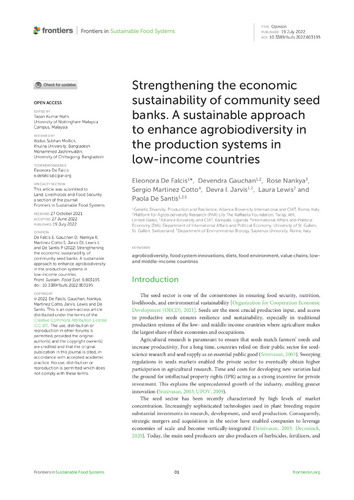Strengthening the economic sustainability of community seed banks. A sustainable approach to enhance agrobiodiversity in the production systems in low-income countries
The seed sector is one of the cornerstones in ensuring food security, nutrition, livelihoods, and environmental sustainability [Organization for Cooperation Economic Development (OECD), 2021]. Seeds are the most crucial production input, and access to productive seeds ensures resilience and sustainability, especially in traditional production systems of the low- and middle-income countries where agriculture makes the largest share of their economies and occupations.
Agricultural research is paramount to ensure that seeds match farmers’ needs and increase productivity. For a long time, countries relied on their public sector for seed science research and seed supply as an essential public good (Srinivasan, 2005). Sweeping regulations in seeds markets enabled the private sector to eventually obtain higher participation in agricultural research. Time and costs for developing new varieties laid the ground for intellectual property rights (IPR) acting as a strong incentive for private investment. This explains the unprecedented growth of the industry, enabling greater innovation (Srinivasan, 2003; UPOV, 2009).
The seed sector has been recently characterized by high levels of market concentration. Increasingly sophisticated technologies used in plant breeding require substantial investments in research, development, and seed production. Consequently, strategic mergers and acquisitions in the sector have enabled companies to leverage economies of scale and become vertically-integrated (Srinivasan, 2003; Deconinck, 2020). Today, the main seed producers are also producers of herbicides, fertilizers, and
other biotech products - such as Monsanto, Syngenta, and Corteva who control over 50% of the global seed market
(Frison, 2016).
The fundamental differences between private and public research have shaped the evolution dynamics of the sector.
Private companies tend to focus on innovations for big markets, both in terms of geographical coverage and crops
of interest. Indeed, while the innovation rate has increased, it has been concentrated on a few crops. Innovation has
adapted crops to specific production and consumption systems (Brooks and Loevinsohn, 2011; Gaffney et al., 2019). Still,
it has often failed to respond to the needs of farmers and consumers in the traditional production systems of low-income
countries (e.g., neglected and underutilized crops and farmers varieties)—that typically have fewer resources to make up for
this innovation gap through public investments and research (Niggli et al., 2017; Macours, 2019).

